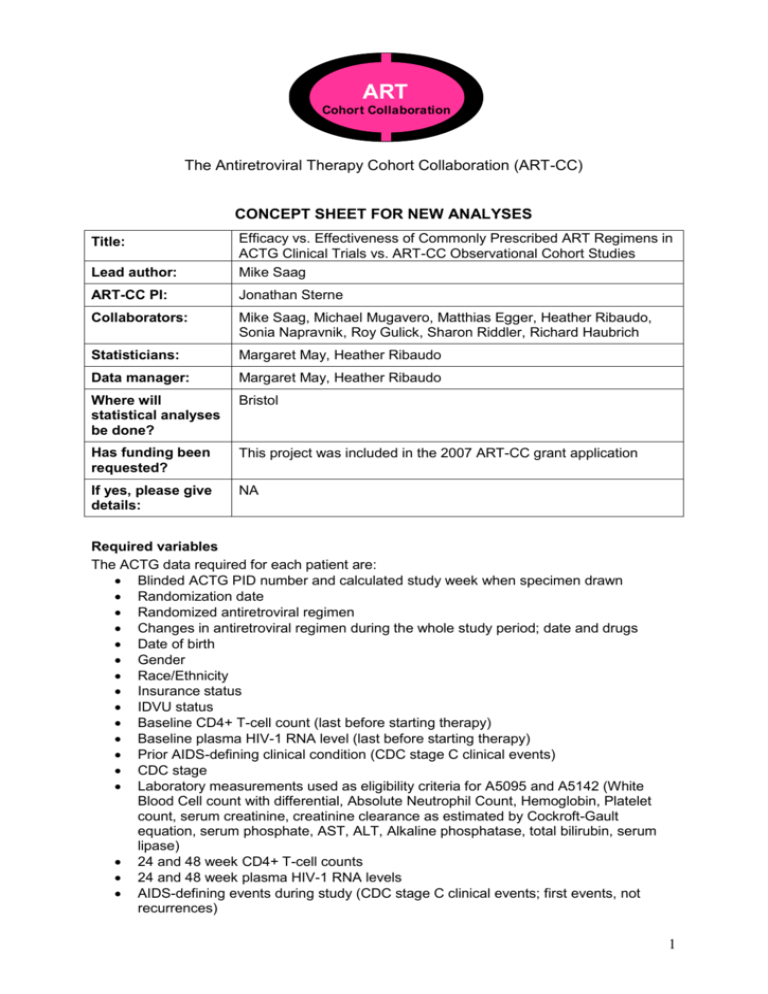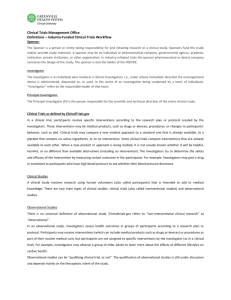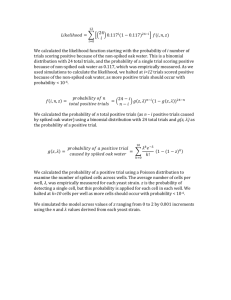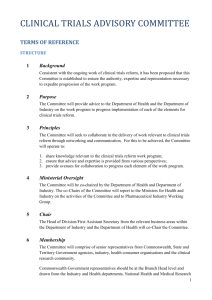clinical trials (Office document, 93kB)
advertisement

a ART Cohort Collaboration The Antiretroviral Therapy Cohort Collaboration (ART-CC) CONCEPT SHEET FOR NEW ANALYSES Lead author: Efficacy vs. Effectiveness of Commonly Prescribed ART Regimens in ACTG Clinical Trials vs. ART-CC Observational Cohort Studies Mike Saag ART-CC PI: Jonathan Sterne Collaborators: Mike Saag, Michael Mugavero, Matthias Egger, Heather Ribaudo, Sonia Napravnik, Roy Gulick, Sharon Riddler, Richard Haubrich Statisticians: Margaret May, Heather Ribaudo Data manager: Margaret May, Heather Ribaudo Where will statistical analyses be done? Bristol Has funding been requested? This project was included in the 2007 ART-CC grant application If yes, please give details: NA Title: Required variables The ACTG data required for each patient are: Blinded ACTG PID number and calculated study week when specimen drawn Randomization date Randomized antiretroviral regimen Changes in antiretroviral regimen during the whole study period; date and drugs Date of birth Gender Race/Ethnicity Insurance status IDVU status Baseline CD4+ T-cell count (last before starting therapy) Baseline plasma HIV-1 RNA level (last before starting therapy) Prior AIDS-defining clinical condition (CDC stage C clinical events) CDC stage Laboratory measurements used as eligibility criteria for A5095 and A5142 (White Blood Cell count with differential, Absolute Neutrophil Count, Hemoglobin, Platelet count, serum creatinine, creatinine clearance as estimated by Cockroft-Gault equation, serum phosphate, AST, ALT, Alkaline phosphatase, total bilirubin, serum lipase) 24 and 48 week CD4+ T-cell counts 24 and 48 week plasma HIV-1 RNA levels AIDS-defining events during study (CDC stage C clinical events; first events, not recurrences) 1 Deaths during study The ARTCC data analysed will match the ACTG data as closely as possible Target journal: For discussion. The ACTG trials were published in NEJM Milestones: Circulation of concept sheet: 12/1/09 Circulation of early draft paper: 30/9/09 Circulation of mature draft paper: 31/12/09 Submission to target journal: 31/3/10 Abstract: ART-CC has compared virologic, immunologic, and clinical outcomes for different ART regimens used in clinical practice [1-2]. These publications emphasized the possibility that observational analyses may be affected by confounding by indication: the only way to exclude confounding is to conduct a randomized controlled trial (RCT). However, RCTs of different ART regimens are typically powered to compare surrogate endpoints - in particular viral load - rather than rates of AIDS and death. Comparisons of RCTs with observational studies have the potential to illustrate the extent of confounding by indication in observational analyses, to improve reliability of observational estimates of effects of different regimens on rates of AIDS and death, and to facilitate investigation of discrepancies between the relative effects of ART regimens on short term and surrogate outcomes, compared with longer term clinical outcomes. They may also illustrate differences between “efficacy” in the tightly controlled clinical trial environment versus “effectiveness” in clinical practice. We propose to compare outcomes in two ACTG trials with those from analyses of ART-CC data, for patients who initiated ART with two nucleoside reverse transcriptase inhibitors (NRTIs) in combination with either efavirenz (A5095, A5142), lopinavir/ritonavir (A5142), or abacavir (A5095) Outline: 1. Background The generalizability of clinical trial findings (efficacy) to outcomes in clinical practice settings (effectiveness) has been widely debated and discussed [3-6]. Several factors are cited as reasons why clinical trial results might not translate to clinical practice. Volunteer bias of subjects enrolled in clinical trials and strict inclusion/exclusion criteria for study participation (selection bias) may result in study populations that are not reflective of the larger population with a given disease. Furthermore, frequent study visits and the increased pill burden from placebo tablets may result in differential results using the same treatment regimens in the setting of clinical trials compared with clinical practice. Confounding is a fundamental problem in the analysis and interpretation of data from observational studies. It occurs when prognostic factors, such as patients’ level of immunodeficiency, determine which regimen is allocated [4, 6, 7]. Such “confounding by indication” has been observed in the selection of ART regimens and can be addressed through multivariable regression analyses. However unmeasured confounders cannot be adjusted for [7, 8]. For example, if physicians’ choice of regimen based on their perception the likelihood that a patient will adhere to treatment then there will be unmeasured confounding, since adherence is not available in the ART-CC dataset. Observational studies have compared virologic, immunologic, and clinical outcomes for different ART regimens used in clinical practice and some have commented on the consistency of findings with clinical trial results [9-13]. However, a formal comparison of the 2 effect of contemporary ART regimens using patient level data from randomized trials and observational studies has not yet been done. 2. Objectives and hypotheses 1. To compare rates of virologic failure (defined as failure to achieve or sustain a plasma HIV-1 RNA < 400 copies/mL) at 24 and 48 weeks among treatment-naïve HIV-1infected patients following the initiation of two NRTIs in combination with efavirenz, lopinavir/ritonavir, or abacavir in the setting of ACTG-sponsored clinical trials with rates of virologic failure in clinical practice, as represented in cohorts participating in ART-CC. Hypothesis: The clinical practice effectiveness in suppressing HIV RNA of all three ART regimens under investigation will be inferior to their clinical trial efficacy, but lopinavir/ritonavir will have a larger reduction in effectiveness when compared to efavirenz (i.e., a larger increase in rates of virologic failure in observational cohorts compared with clinical trials). 2. To compare immunologic response at 24 and 48 weeks of therapy controlling for CD4+ T-cell counts at start of therapy among treatment-naïve patients following the initiation of two NRTIs in combination with efavirenz, lopinavir/ritonavir, or abacavir in the setting of ACTG-sponsored clinical trials with immunologic response in clinical practice, as represented in cohorts participating in ART-CC. Hypothesis: Differences in immunologic response seen in clinical trials will not be observed in observational cohorts. 3. To compare rates of AIDS-defining conditions and death among treatment-naïve patients following the initiation of two NRTIs in combination with efavirenz, lopinavir/ritonavir, or abacavir in the setting of ACTG sponsored clinical trials with rates in clinical practice, as represented in cohorts participating in ART-CC. Hypothesis: Differences in clinical outcomes will not be observed in clinical practice relative to clinical trials. 3. Study design We will compare the outcomes listed above for patients whose initial ART regimen contains two nucleoside reverse transcriptase inhibitors (NRTIs) in combination with either efavirenz (A5095, A5142), lopinavir/ritonavir (A5142), or abacavir (A5095) [14-16]. Since the NRTI pair was by choice and not by randomization in A5142, we will initially compare the third drugs in the regimens pooling all NRTI pairs. We will then compare specific drug regimens, such as zidovudine/lamivudine (ZDV/3TC), tenofovir/lamivudine (TDF/3TC), and stavudine/lamivudine (D4T/3TC) in combination with the above specified third drugs, in models that include terms for the interaction between the NRTI pairs and the third drugs. Data from both trials have been sent to the ART-CC coordinating team in Bristol, so analyses can commence as soon as the 2009 ART-CC dataset is available for analysis. 3.1 Eligibility criteria 1. Patients enrolled in A5095 and A5142 receiving two NRTIs in combination with efavirenz, lopinavir/ritonavir, or abacavir. 2. ART-CC patients initiating the specified ART regimens recruited on or after 1st January 2000 and at least one year before the database close date. 3.2 Key variables and definitions Drug regimens, variables that determine eligibility for trials, patient demographics, CD4, VL and clinical outcomes. 3 3.3 Outcomes Virologic failure and immunologic response at 24 and 48 weeks, and available clinical outcomes (rates of AIDS-defining events and death) following the initiation of ART. 3.4 Statistical methods Objective1: We will consider virologic failure as having failed to achieve or sustain a plasma HIV-1 RNA <400 copies/mL at 24 and 48 weeks of therapy. The intent-to-treat (ITT) population will be used. Two analyses will be conducted to assess the proportion of patients with plasma HIV-1 RNA levels <400 copies/mL; the observed ITT analysis (ITT-O) and the missing-equals-failure ITT analysis (ITT-M=F). The ITT population will be defined as all patients who were exposed to at least 1 dose of the initial therapy regimen. The primary analysis will be the ITT-O analysis, in which only available assessments will be used (no imputation for missing values). We will conduct an ITT-M=F analysis as a sensitivity analysis, all missing values and values for patients who had switched to other PIs or NNRTIs (assessed at 6 months in ART-CC) will be considered as failures. Temporary discontinuations, and switches between NRTIs, will be ignored in these analyses. To ensure comparability of groups we will perform rigorous analyses adjusting for any possible differences in prognostic variables at therapy initiation between patients enrolled in ACTG trials and patients in ART-CC, including all factors listed above. Multivariable analyses will be fit with binomial regression models. Objective 2: We will compare CD4+ T-cell counts at 24 and 48 weeks after start of therapy in models that control for baseline CD4+ T-cell counts. Objective 3: We will consider as clinical outcomes an incident AIDS-defining clinical condition or death. Patients will begin contributing person-time from the date of therapy initiation. The date of an incident AIDS-defining clinical condition or death will correspond to an outcome endpoint. If patients are event free at the end of follow-up time (defined as end of study follow-up for ACTG participants and last clinic visit plus 3 months for ART-CC patients) their time will be censored on that date. If a patient is lost to follow-up their time will be censored at their last known contact plus 3 months. Time to either an incident AIDS-defining clinical condition or death, whichever occurs first, will be evaluated using Kaplan-Meier survival curves. Multivariable models will be fit using proportional hazards regression to adjust for possible confounding. Log-log survival curves and Schoenfeld residuals will be used to assess proportionality of hazards. To evaluate possible lack of generalizability of the RCT results, we will apply (as far as possible) trial inclusion/exclusion criteria to ART-CC patients, and stratify analyses of ARTCC data according to whether patients were eligible to participate in the trials. For all outcomes, we will consider whether any discrepancies in estimates of the relative effect of ART regimens between the trial and observational data might be explained by the inclusion/exclusion criteria for the trials, for example those based on laboratory measures such as ALT, AST or creatinine clearance, or current infection. If results from observational cohort studies are in agreement with results from clinical trials, it would give a strong indication that the trial results are generalizable to practice settings, particularly to patient population groups excluded from trials. If results are in disagreement, it is important to investigate the extent of, and possible reasons for, discrepancies between the results of trials and observational studies. Finally, we will evaluate the extent to which short-term surrogate endpoints are useful surrogates for clinical outcomes, using established statistical criteria for evaluating surrogate endpoints. 4 3.5 Sample size considerations For ACTG the estimated sample size is 1266 (A5095: ZDV/3TC/EFV N=382, ZDV/3TC/ABC N=382; A5142 N~502). For ART-CC the estimated sample size in the 2006/7 dataset was in excess of 9,050 (ZDV/3TC/EFV N=3,137, ZDV/3TC/LPV/r N=2,131, ZDV/3TC/ABC N=1,814, TDF/3TC/EFV N=708, TDF/3TC/LPV/r N=259, D4T/3TC/EFV N=578, D4T/3TC/LPV/r N=423). 3.6 Ethical considerations NA 4. References 1. The ART Cohort Collaboration. Rates of disease progression according to initial HAART regimen: A collaborative analysis of 12 prospective cohort studies. Journal of Infectious Diseases 2006 194: 612-622 2. The ART Cohort Collaboration: Does short-term virologic failure translate to clinical events in antiretroviral-naïve patients initiating antiretroviral therapy in clinical practice? AIDS 2008; 22: 24812492. 3. Benson K, Hartz AJ. A comparison of observational studies and randomized, controlled trials. N Engl J Med 2000;342:1878-86 4. Chalmers I. Unbiased, relevant, and reliable assessments in health care: important progress during the past century, but plenty of scope for doing better. Bmj 1998;317:1167-8 5. Concato J, Shah N and Horwitz RI. Randomized, controlled trials, observational studies, and the hierarchy of research designs. N Engl J Med 2000;342:1887-92 6. Pocock SJ, Elbourne DR. Randomized trials or observational tribulations? N Engl J Med 2000;342:1907-9 7. Hughes MD. Initial treatment of HIV infection: randomized trials with clinical end points are still needed. J Infect Dis 2006;194:542-4 8. Wood E, Hogg RS, Heath KV, et al. Provider bias in the selection of non-nucleoside reverse transcriptase inhibitor and protease inhibitor-based highly active antiretroviral therapy and HIV treatment outcomes in observational studies. Aids 2003;17:2629-34 9. Easterbrook PJ, Newson R, Ives N, Pereira S, Moyle G and Gazzard BG. Comparison of virologic, immunologic, and clinical response to five different initial protease inhibitor-containing and nevirapine-containing regimens. J Acquir Immune Defic Syndr 2001;27:350-64 10. Friedl AC, Ledergerber B, Flepp M, et al. Response to first protease inhibitor- and efavirenzcontaining antiretroviral combination therapy. The Swiss HIV Cohort Study. Aids 2001;15:1793-800 11. Lucas GM, Chaisson RE and Moore RD. Comparison of initial combination antiretroviral therapy with a single protease inhibitor, ritonavir and saquinavir, or efavirenz. Aids 2001;15:1679-86 12. Phillips AN, Grabar S, Tassie JM, Costagliola D, Lundgren JD and Egger M. Use of observational databases to evaluate the effectiveness of antiretroviral therapy for HIV infection: comparison of cohort studies with randomized trials. EuroSIDA, the French Hospital Database on HIV and the Swiss HIV Cohort Study Groups. Aids 1999;13:2075-82 13. Weiser SD, Guzman D, Riley ED, Clark R and Bangsberg DR. Higher rates of viral suppression with nonnucleoside reverse transcriptase inhibitors compared to single protease inhibitors are not explained by better adherence. HIV Clin Trials 2004;5:278-87 14. Gulick RM, Ribaudo HJ, Shikuma CM, et al. Three- vs four-drug antiretroviral regimens for the initial treatment of HIV-1 infection: a randomized controlled trial. Jama 2006;296:769-81 15. Gulick RM, Ribaudo HJ, Shikuma CM, et al. Triple-nucleoside regimens versus efavirenzcontaining regimens for the initial treatment of HIV-1 infection. N Engl J Med 2004;350:1850-61 16. Riddler SA, Haubrich R, DiRienzo G, et al. A prospecitve randomized, phase III trial of NRTI-, PI-, and NNRTI-sparing regimens for initial treatment of HIV-infection - ACTG 5142. In Program and Abstracts of the XVI International AIDS Conference, 13-18 August 2006, Toronto, CA: abstract THLB0204. 5








